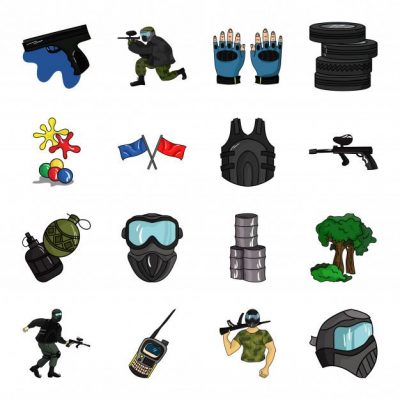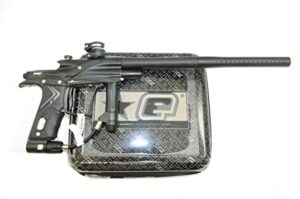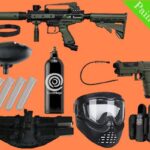Choosing the best paintball marker can be a tough decision. There are more than 100 different kinds of markers to choose from. Which one would be right for you?
In this article, I will be going over a few points to consider when choosing a marker to hopefully help you make the right decision. There are so many features that markers have that some players do not understand the purpose of it.
I shall also discuss purchasing options and items to look for if you choose to buy a used marker.
The most important thing that one should not do when choosing a marker is not to pick one up because so-and-so has one. If there are any terms that you do not understand, please refer to the Ultimate Paintball Dictionary
Wanting your marker?
The first thing that you should ask yourself is how involved are you in the sport of paintball. Owning your marker can be a neat thing. Show off to your friends and fellow players what you have. Maybe wanting to tinker with it is something that you may want to do. Another reason for buying your marker is simply not liking to rent the field markers or borrow somebody else.
These are all fine reasons for wanting to own your best paintball marker. But I will have to mention that sometimes, owning a marker is not the best thing. If you play paintball up to 3 or 4 times per year, the marker may see more dust bunny action than paintball action.
Why would you want to spend up to $250 to $500 on basic equipment if it is just sitting around? However, if you are willing to spend some time with maintenance of the equipment before and after the game/storage, then owning your marker could be fine.
Another point to the above is if you do not play that often or will not be playing in tournaments, why spend $500 plus on a marker? I always look at all my purchases as an investment. That goes with wants and needs. In the case of a paintball and a non-tournament player, a marker is a want. Wants should not have a large price tag.
For the player that plays often or will be entering tournaments, the best paintball gun is a need and should be invested accordingly.
Additional Tips for Choosing the Best Paintball Marker:
Then there is the not liking those rentals. It is common to experience the marker that you have chosen to rent breaking down in the middle of the game. Remember, that marker has suffered much abuse from previous players. Even from the field staff that has the job to maintain them. If you have 10 markers to clean and oil, you may tend to do a rush job.
I don’t want to talk badly about the field staff. Not all are that way. Out in the field, the markers may have been dropped, banged into a tree, or anything else that a new player can do… accidentally. That can ‘encourage’ a player to buy his or her marker and vowing to take better care of it than those field rentals.
Seeing all the different markers in the field with different paint jobs and gadgets can be very appealing. And with these gadgets comes a price tacked onto that performance enhancement. There may be raves of gadgets that some may want to add to their marker because the so-and-so player has it.
Adding upgrades will run the price tag up from the initial purchase of a marker. There is nothing wrong with adding sensible upgrades that will increase performance. But there are a few items that you do not need.
Now, owning your marker can be of benefit. No need to borrow a friend’s marker and worry about breaking it. Knowing that you have put the time into the maintenance of the marker will ensure you will have an operating marker in the field. Though, some goofs may happen.
Renting is usually an additional fee next to the entrance fee for a field. If you play often, this will add up. Over a while, this will add up quickly. And, for those that play outlaw (homemade paintball fields), needing your equipment is needed. After considering the above items, if you still feel that you would like to own your marker, then we shall move on to the next step of looking at the different features of the best paintball marker.
The Features:
- A paintball marker all have basic equipment.
- From bolts and barrels to grips and cocking mechanisms.
- From paintball manufacturer to paintball manufacturer, these will have different designs.
- The functionality is the same.
- An air source is connected.
- The bolt moves forward and backward loading a paintball.
- The trigger is pulled to open a valve by some means.
- A barrel ‘stabilizes’ the trajectory of a paintball.
- Then you have different firing mechanics. From pump to semi-automatic to electronic.
The following items below will be a discussion of the basics of a marker and why it was designed that way. This may help you in looking for a marker with a specific feature that you are looking for.

Bolt:
The bolt is a piece of equipment that many manufacturers will claim helps to improve accuracy and/or range. I do not believe this. Accuracy and range are dictated by two other elements. One being a regulator and the other a good paint-to-barrel match.
More on this later. Back to the bolt.
On different markers, the two terms that may be heard are an open bolt and a closed bolt. This is referring to the position of the bolt when in the cocked position.
There have also been debates on which type of action is more accurate. But has been proven that both are equal given the same base values. Bolts have been made from many different materials. From brass to aluminum. And, the new rave, Delrin. Typically, o-rings are added to bolts. The purpose of the rings is to help keep the bolt centered in the breach and reduce friction. Oil is used to help reduce friction.
Delrin is different as it requires no o-rings or lubrication. It has been advertised as being ‘self-lubricating’. Delrin is also lighter than metal bolts. I do have a slight problem with Delrin that I have experienced One is that if you accidentally oil it, do not keep it clean, and/or play in humid environments, it tends to swell. This swelling will also start to increase friction and may cause it to get stuck.
Another problem that this has is the space between the bolt and the breach is open. Air can escape when the marker is fired. Not exactly air efficient. Other than those two points, they are fine bolts. A daring bolt is typically a separate purchase from an aftermarket manufacturer.
The bolts made out of metal are heavier and have more friction than the Delrin. Though, with some elbow grease, you can sand and polish the bolt (and other moving parts) with very fine sandpaper and metal polish that will provide equal friction-free movement like the Delrin.
Plus, with the addition of o-rings, the air is directed in the right direction. One may ask, why not add o-rings to the Delrin? Well, to help the o-rings have a good seal, one must add oil to the rings. And, as I mentioned in the previous paragraph, oil, and Delrin do not mix.
Another feature that bolts have (metal or Delrin) is the venturi. This is typically some sort of piece of metal that is shaped to ‘break up’ the flow of air to hit the paintball in the breach more evenly.
I have been playing since 1997. Of all the raves and fads that I have seen developed for the best paintball equipment, this is probably the worst item, in my opinion.
Sure, it does as it is advertised. But it also requires you to use more air to push the paintball due to this restriction. Not only that, but the paintball doesn’t misshapen from the blast of air all the time. For one thing, paintball gear is not perfectly round. So it is already malformed. It is usually wider at the seam and thinner at the poles. When the paintball goes from 0 to 300fps, it may disinform for a split second. Maybe less.
But it will return to its original shape and remain that way. A marker with one inside should not make or break a decision of a purchase. Venturi’s are relatively easy to remove by unscrewing them or drilling them out if one wants to. No need to replace the bolt. It is, what I call, an extension of the valve. It directs the air from the air source to the back of the ball.
It does nothing else.
Barrel:
A barrel is what directs the paintball from the breach to the target. It is nice to be able to remove the barrel from the marker. This should be a consideration in a purchase. Plus, look to see what other manufacturers make barrels for that type of marker. Usually, the stock barrel is not manufactured the best.
So, buying a new barrel may either match the paint you use, quiet the marker due to porting, or gives you a more desirable look. Maybe all of the above.
- Barrels come in different lengths, shapes, and types of material.
- Materials may offer different characteristics to a paintball when fired.
- Barrels have varying sizes inside called a bore.
This bore is measured to the third decimal place. Also, paint is measured to the third decimal place. In short, a paintball that is too small for a barrel may roll out of the marker when the barrel is pointed down. A paintball that is too big may need more air to push it out of the barrel. It may even break due to the tight clearance.
Having the right paint-to-bore match will help with range and accuracy. But, it is all considered .68 caliber. I encourage you to read over the article Barrels – F.A.Q. for more information on barrels.
Valve:
The valve is the least upgraded item on a marker.
Why?
It was designed for that marker to operate at top performance out of the box. Getting a new valve may not increase its performance. Just decrease the money in your wallet. Unless you choose to heavily modify the marker.
For instance, turning a Spyder or an Autococker to run at a lower psi. This will involve either modifying the existing valve to allow the air to flow better. Or, simply purchase a new valve that is less air-restricting. This would be the only real reason to replace the stock valve.
There are also electronic valves like the Shocker and Angel. Unlike its mechanical cousins where a hammer will hit a valve to open and allow the air to flow. The electronic valve is electronically opened and closed. Electronic valves are more prone to dirt or even paint breaks. Replacing it because it ceases to function may cost you some money if not within warranty.
Feeds:
Yes, this is something that may be of consideration for a marker. This is the part that a hopper is attached to. It enables a route to transfer paintballs from the hopper to the marker. There are three basic feeds. Direct, power, and vertical.
The direct feed is the basic feed that was attached to markers in the early days. It was simply a tube attached to a 45* angle of the breach. This sets the hopper to the side. This is a slower feed than the next two. The Automag Classic features this type of feed.
With faster firing markers, blowback seemed to be a troublesome thing to happen and caused needless paintball breaks and misfeeding. The power feed was then introduced. This used the negative effect of blowback and turned it into something positive.
This feed is also mounted on a 45* angle but in such a way that when the blowback pushed the paintball up, it would hit the wall of the feed, and bounce down into the breach. This increased the rate of fire. The downfall of a power feed is for those using sights. The power feed blocks the field of view over the marker in some cases.
The vertical feed is a tube mounted on the top of the marker. This will increase the feed rate of paintballs as compared to a power feed. Paintballs seem to feed faster thanks to gravity. With the vertical feed, the paintballs are stacked in a straight line. Some markers may feature feeds that can be removed.
Aftermarket manufacturers offer products with shorter or longer feeds. The downfall of the vertical feed is that it increases the profile height, providing your opponent with more of a target to shoot at. You also cannot sight over the top of the marker. The sighting has to be done from the side. There is one other type of feed that is specialized. It is for pumps and is called the horizontal feed.
If you have seen really old pictures of paintball in its early years, you may have seen pumps with no hoppers. These feeds are still available to pumps and are referred to as “stock class”. Unlike the faster-firing cousins, pumps can utilize this type of feed.
Grips and Triggers:
- M-16 assault
The very basic and inexpensive models of markers may come with M-16 style grips. These are the same grips that are mounted on the M-16 assault rifle that the armed forces use. For some, it may be an acquired feel. But if one breaks (they are made of a polymer), one can replace it with one cheaply.
- .45 grip
Another style is called the .45 grip. This is the same type of feel as the .45 cal 1911 pistol. Not named for the angle that it sits. For most, this is the most common type of grip that a marker will have. If not that, then the most common upgrade for a marker that doesn’t come with one.
- Angel IR3
Other markers may have designed a radical look to a grip. Like the Angel IR3. This is designed for the tournament player. Another different grip is the ‘Z’ grip for the AutoMag. Both of these grips allow the player to hold the marker in such a way that it is close to the body giving a small target profile.
- Single or Double
Triggers on some markers can be single or double. The double allows the index and middle finger to rest on the trigger. This may also allow at least one finger to be on the trigger if the player needs to have the marker up close. Also, for some players, the middle finger may be able to pull the trigger faster. The double trigger is more common than the single trigger.
- pre-2003 models
To go further, some markers allow adjustment of triggers for a longer or shorter pull. This is mainly for those that are electronic markers. For the Autococker, the pre-2003 models came with a sliding trigger. For some players, this was hard to get used to.
The type of grip and trigger is a personal preference. The most common is the double trigger mounted on a .45 grip frame. For those that do not like the stock frame, there are plenty of manufacturers that make replacement frames and triggers in an assortment of materials and colors. When choosing the best paintball marker, I suggest that you hold different frames and find out what is comfortable for you.
Air Handling:
This may seem odd as being a consideration in a marker. But should be considered. CO2 is the most common air used in paintball. But quickly fading. It is giving way to high-pressure air and nitrogen. Some markers will run better on one type of gas rather than another. Other markers will run equally. Yet, some markers require a specific gas to run at peak efficiency.
Most electronic markers require you to run HPA because CO2 can freeze and damage the electronics. Though, AutoMag is suggested to run HPA, even though it is not electronic. It is how the innards are designed. The Smart Parts electronic markers run best on HPA. Though, because of the design, they can run equally as well on CO2. Then, the older Tippmans run better with liquid CO2 inside of them.
HPA tanks are more expensive and will add to the cost of a marker. CO2 is relatively cheap. The largest CO2 tank can be purchased for under $30. A small HPA tank can be purchased for around $80. See CO2 and HPA/Nitro – FAQ for more info. Along the lines of air, handling is how the tank is mounted. Some markers require you to use the 12g only. Such as those considered stock class.
Other markers require you to purchase additional items (either from the same manufacturer or an aftermarket manufacturer) to mount the tank on the grip. Most markers have everything. One nice feature is if the marker comes with a drop forward. A drop forward is a nice feature. It enables you to mount your air tank slightly forward giving the marker a better feel.
The Smart Parts and some of the Kingman markers come with a type of drop forward as a standard. But there is aftermarket drop forwards of varying sizes.
- Lastly
Does the marker have a regulator?? Many of the mid-range markers come with a regulator. Some, like the AutoMags, come with one built-in. A regulator is a great feature as it will make your shots more consistent.
This translates into better accuracy since the psi is the same. Now, there are some markers that you can add a regulator to. This may require you to add one or two smaller priced items (air-line, air fitting, adaptor). But by adding a regulator will greatly add performance to any marker.
Maintenance:
One consideration that should be considered is the ease of maintenance. Not only that but how much is needed. Maintaining your marker should not take that long for simple procedures. That is cleaning broken paint or mud from inside the breach, oiling the o-rings, checking for leaks, and wiping down the inside. The major internal overhaul may require more time, but should not be counted.
Weight:
This may be a concern to some buyers. When markers were first made, brass was the choice material. It was easy to work with because it was a soft material.
However, it was heavy. Aluminum is today’s most common material. Blocks of aluminum are machined to make the body and other parts. Individual smaller parts like the bolt, valve, hammer, grip, etc. can be made of the same or other materials such as stainless steel, titanium, polymer, and many others.
This will add or subtract the weight of the overall marker. Also, don’t forget a full hopper and an air tank. In my opinion, a fully loaded Autococker or an M98 may be weighty whereas a Spyder or Impulse is relatively light. While you’re checking out the grips, take note of the weight.
Upgrades:
This may be a buying feature for some. Some markers may have hundreds of upgrades available for it. Others may be limited. Those markers that are pumped will not have that many upgrades available. It is a very simple marker. The lower-priced markers will have several upgrades. Seems like you can make a marker from scratch using aftermarket parts.
The higher-priced markers may not have as many upgrades. This is because the engineering put into those markers has analyzed the mechanics of all the parts. For all of the markers, a barrel is the most common upgrade. Some may want to take a mid-price range marker and add a bunch of upgrades. I have made an Upgrades – FAQ. It is geared for the Spyder. However, many of the thoughts in the article can fit most markers.
The Looks:
This may be associated with upgrades. Seeing what upgrades are available for a marker that you are interested in may give your marker a certain look that you want. Some of the markers look pretty nice out of the box. But as a word of caution, most of the cosmetic upgrades are just that, cosmetic.
They will not enhance the performance of the marker. The bottom line is a personal preference. The above items should be considered. Then of the few markers that are left standing, go for the one that appeals to you. The looks can also be in the form of anodizing and/or milling.
There are some markers that have unique colors that may appeal to you. Even some manufacturers will do special colors for you upon request. This will increase the price tag.
Electronic or Non-electronic:
This is a personal preference. The electrons are real nice since they have adjustable trigger pulls. Some come with fire modes. The Angel comes with a clock, thermometer, and timer with a vibrating signal, and can even tell you it needs oil at a certain part of the marker.
Of course, this same marker will be asking for a higher price tag. One thing that you need to make sure of is that you have fresh, fully charged batteries. You will look rather silly walking off the field with a dead marker. Slightly more care needs to be headed during maintenance.
- For the non-electronic markers, no batteries are required.
The worst thing that can happen is a breaking point or a leak in the air lines. Simple maintenance procedures. Though, you will not have the fire modes like a 3-shot burst or full auto. Then again, some fields do not allow higher than semi-auto. Especially in tournaments.
I shall throw in pumps here. Pumps (especially stock class markers) are making a small comeback. These are the simplest of markers. The players use markers as I did back in the 1980s.
Limited to 10-20 paintballs, 12g cartridge, and pump action. Pumps are able to mount the 200-round hoppers and use the bulk CO2 tanks. It all depends on the model. Some markers enable you to switch breeches between stock class legal to direct or vertical feed.
The CCI Phantom is an excellent example of this. Even though you are lacking in firepower, using a pump marker tends to use their heads and not their marker. In other words, you build on your skills.
Price
This is something else that should be considered.
The price of a marker can go from $30 all the way up to $2,000. There are three price ranges for markers.
It is really hard to dictate what marker goes whereas many are being dropped from production and others added. Others are personal opinions. But, choosing a marker from a certain class should not be that important.
A marker that is considered low-end can compete just as well with the higher range of markers. The outcome of a game is mostly the skill of the player, a small piece of opportunity, and the smallest portion being the marker.
I believe that entirely.
A marker is a tool for the player. A player lacking in skill will not use his tools well. I have seen stock-class players do very well against another team with the higher end of markers. If you are looking into getting a marker for the first time, look for a low to mid-range marker. Tippman, Kingman, and JT offer good, yet inexpensive, markers that are very forgiving to the new player.
Smart Parts, WGP, AGD, and Indian Creek are stable markers that are for the player that wants a little more marker.
They have markers for under $600.
These manufacturers offer markers that are proven in the field with plenty of upgrades available for those that like to tinker. When you have the experience and playing (or the desire to play) in many tournaments, look to the higher-end markers.
But, I am not at all saying that the mid to lower markers will not compete in the pro circuit. Any marker can be used if in the right hands. As I said before, it is the skill of the player that will decide the outcome of a game. You may be able to score an excellent deal for a used marker that is up for sale. Maybe a marker on consignment at a paintball shop. Many times, these are an alright buy.
- First of all, you will get a great marker with some upgrades for the same price as the best paintball marker of the same type that is stock brand new.
- Second, you may have a marker that has the right upgrades. Less for you to add. Be, be cautious. Ask the owner of the marker (not the store owner that is selling it) if there is anything wrong with it. Gas it up to check for leaks. Dry fire it.
- If possible, try it out in a game. You may find that all looks well until you actually play a game with it.
Another fair place to get used equipment is from auctions (like Amazon) and personal ads on internet forums. Be mindful of the seller. You can’t judge this by its cover.
Ask for references. If this is the first time that he is selling, use a third party (I offer that for a minimal fee). As much as I hate to say this, do not trust the other person unless (s)he has good references or a good track record. Ask for the person’s phone number. Use email and state everything so that it is in writing.
This written “agreement” can be used just in case you do not get what you were expecting. Never send cash. Use delivery confirmation/signed receipt. All of the above is from my personal experience.
Some good, and some bad moments I have.
I have used the US Postal Service with excellent results. If the person you are buying from cheats on you by not sending the item purchased, you are protected under federal law.
Another thing that I have found. Selling a marker with upgrades may sell for the price of the same marker stock. Just like I mentioned above that you found a great deal on the best paintball pistol, but be in the mindset that the seller is technically losing money.
- Look at the Angels.
I have seen new base models go for around $1,200 new. The following year, the same marker is being sold for $900, even $800. I have found that buyers tend to want to buy brand-new items rather than risk on used ones. So that makes the seller drop the price to get rid of it.
Ultimate Buying Guide for Best Paintball Marker
As a final thought for choosing the best paintball marker, it boils down to personal preference. The weight and feel of the marker may outweigh whether you have a power feed or vertical feed. Remember, you are the one that will be playing with the marker. If at all possible, talk to the owners of the markers that you are interested in. Ask them how well they like them, maintenance, and common problems that the marker will have.
Please collect as much information as you possibly can collect. Most of the manufacturers have boards on their websites that you can visit and ask questions. One question I get a lot is how the Kingman Shutter shoot as compared to a Spyder Xtra. The only difference is that one is a power feed and the other is vertical.
It shoots the same otherwise.
The same goes for comparing the E-99 versus the Xtra. The E-99 has an electronic frame whereas the Xtra does not. Put that difference aside, along with the color, it shoots the same. Cleaning and maintenance are the same.
It is simply those small differences that one must consider. Weigh both the pros and cons. Back to the Shutter vs Xtra. The shutter with power feed is slower in loading paintballs than the Xtra but has a lower target profile.
This brings me to this point that many have not agreed with me about. It is true that the more money you spend on a marker, the better quality one will have. That is, spending $150 for an M98 versus spending $300 on an Autococker will give you more marker by spending that extra $150.
However, a paintball traveling at 285fps from an M98 will go the same distance as an Autococker traveling at 285fps (given the right paint-to-barrel match). I could compare a PGP with an Angel. If both are firing at the same velocity, the paintball will go the same distance.
This could be really stretching it when comparing these two markers. Really, as soon as that paintball leaves that barrel, the marker has no further effects on the best paintball marker.
Final Thought
Well, I think that is all that I can share with you in choosing the right marker. I may add more later as I think of it. Until then, buy smart, and play safe.












[…] things considered, paintball markers take shots at a speed of 300 feet for every second (fps). In any case, you’ll need a skull mask […]
[…] them from the game, by hitting them with your paintball pellets (colored dye capsules) fired from paintball marker guns. The team finally wins the game by capturing the other team’s […]
[…] you are looking for a serious paintball marker then you could do well to look into Tippmann A5. Also, you can use upgraded 98 custom on steroids. […]
[…] Paintball Marker […]